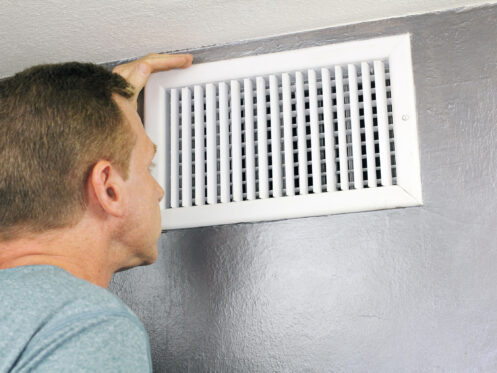Updated September, 2025
Weak airflow and uneven temperatures often indicate that the static pressure in the ductwork system is too high or too low. High static pressure can lead to higher energy bills and put unnecessary stress on the HVAC system.
In this article, we’ll provide a complete overview of what static pressure is, what can cause it to be out of the recommended range, and what options you have for fixing issues.
What Is Static Pressure?
Static pressure is a measurement of how much resistance the air flowing through a ductwork system encounters. When this metric falls within the recommended range, air flows smoothly through the ductwork and is evenly distributed throughout the building.
When the static pressure is too high, the increased resistance makes it more difficult for the HVAC blower to circulate air through the ductwork properly. This can lead to long run times, increased energy consumption, and greater wear and tear. High static pressure also causes an HVAC system to produce more noise and causes ducts and vents to rattle significantly.
If the static pressure is too low, it usually results in improper air balancing. That means there is insufficient airflow to reach all parts of the building, resulting in warmer and colder areas. The blower also has to work much harder to move air through the ducts, which often results in it wearing out prematurely.
Common Causes of Low Static Pressure
Low static pressure can occur for several reasons. For example, the blower may be too small for the HVAC system, or the fan speed may be set too low, preventing it from circulating air sufficiently. If a technician determines that the blower is too small, you’ll need to replace it to fix the issue.
While this is somewhat expensive, it can pay off in the long run by reducing your energy bills, protecting the life of your HVAC units, and leading to an overall improvement in comfort.
You can also end up with insufficient static pressure if the supply and return ducts are too large for the HVAC system. Unfortunately, the only option in this situation is to replace your ductwork, which is a significantly more expensive alternative. That’s why you should make sure to hire an experienced, reputable HVAC company like Environmental Heating & Air Solutions when the time comes for ductwork installation and replacement.
Leaky ductwork can also cause low static pressure. Over time, ductwork joints can loosen and cause air leaks. Ductwork in damp or humid locations can also corrode over time, resulting in holes that allow air to escape. Because most ductwork is behind walls, in crawl spaces, or other hidden locations, corrosion can be extensive and unchecked in some homes. A low static pressure reading is a great reason for us to examine whether your system is intact and sealed tightly.
What Can Cause High Static Pressure?
High static pressure is a far more common problem. One reason why many homes experience frequent issues with high static pressure is that they don’t replace the air filter in their HVAC system often enough, resulting in the filter becoming clogged and creating substantial airflow problems. Using a filter that is more efficient than the HVAC system is designed to handle also restricts airflow and leads to an increase in static pressure.
Closing some of the supply vents is another common mistake that can lead to high static pressure. For an HVAC system to work correctly and circulate air evenly, the same volume of air needs to come in through the return vents as it does out of the supply vents.
When some supply vents are closed, this creates an imbalance that results in more air continually backing up in the supply ductwork and increasing the pressure. Blocking vents with heavy drapes or keeping furniture, such as sofas, on top of ducts can produce similar results.
Dirt and debris inside an HVAC system also contribute to high static pressure. For instance, if there’s lots of debris inside the ductwork or the AC evaporator coil is clogged with dust, it creates increased friction. The friction means the air encounters more resistance and can’t flow as smoothly.
Improperly designed ductwork is yet another issue that can lead to excessive static pressure in an HVAC system. The most common design issue is when the ductwork is too small for the size of the HVAC system. If the return ductwork is smaller than the supply ductwork, it restricts the amount of air the blower can draw in, leading to a substantial increase in static pressure on both the supply and return sides.
Another issue we sometimes encounter is that the ductwork has too many bends and angles. Bends create additional friction and higher pressure, as the air encounters more resistance when it has to change direction.
How to Fix and Prevent Issues With High Static Pressure
High static pressure caused by improper ductwork design is something you can only fix by having an HVAC company redo some or all of your ducts. Luckily, most of the other causes of high static pressure are fairly easy to avoid.
One of the most significant steps is to replace your air filter regularly, which usually means at least once every two to three months. The easiest way to do this is to schedule a recurring reminder on your phone or digital assistant. If you notice issues with weak airflow and uneven cooling or heating after replacing the filter, it may indicate that you need to use a lower-rated filter.
Keeping all supply vents open and ensuring that nothing obstructs the airflow coming out of them is also important for preventing an increase in static pressure and ensuring effective cooling or heating performance. You should also occasionally remove and clean the cover on all supply and return vents to make sure they don’t get clogged. Having your return vents clogged with hair and debris is a particularly significant issue, as it reduces the airflow entering the HVAC system.
Professional heating and AC maintenance is a reliable way to monitor static pressure and avoid or address the issues associated with it. Our professional HVAC maintenance involves tasks such as cleaning the evaporator coil, which helps reduce friction and maintain lower static pressure. Cleaning the blower is equally important for ensuring it can effectively circulate air throughout the ductwork.
Regular maintenance appointments can also prevent many of the common issues that contribute to ineffective cooling and heating, higher energy bills, and increased strain. This last factor is especially important, as it helps reduce the need for repairs and prevents your HVAC system from failing prematurely.
Lower Static Pressure to Protect Comfort and Equipment
High static pressure strains motors, amplifies noise, and starves rooms of airflow. Common causes include restrictive filters, undersized returns, and crimped flex. If registers are loud or airflow is weak at far rooms, testing total external static and filter drop will point to the bottleneck.
What to Address First
- Measure and correct restrictions at the source. Our ductwork team can open returns, straighten runs, and right-size filter cabinets.
- Confirm the building is not fighting the system. Use blower door testing to spot infiltration that forces longer runtimes and higher pressure.
Expect quieter operation and better room-to-room balance once static is back in spec. Correcting pressure protects blowers and can extend equipment life.
Environmental Heating & Air Solutions is a premier heating, ventilation, and air conditioning company that serves homeowners in northern California, including Benicia, Roseville, and the surrounding areas. Our experienced technicians have years of experience in the full range of HVAC services and can help you overcome any problems with your home’s cooling or heating.
Whether you’re dealing with poor airflow, high energy bills, or anything else, give us a call to get the expert assistance you need.

